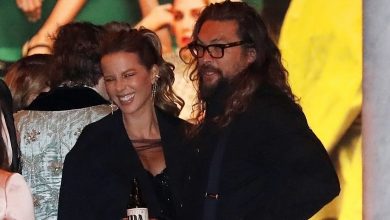‘Tokyo Vice’, a trip to the underworld of the ‘yakuza’

The HBO series tells the story of a journalist persecuted by the powerful mafia, but also offers a portrait of contemporary Japan
The American Jake Adelstein was the first western journalist who managed to be part of the editorial staff of the Japanese newspaper Yomiuri Shimbun, which, at the end of the nineties, was a transatlantic of the international press, the newspaper with the largest circulation of paper copies in the world, 13.5 million. As a crime reporter he worked with many sources in the police, but also among the bosses of the yakuza, the Japanese mafia. He ended up having to flee, becoming a kind of Roberto Saviano, because one of the most powerful clans sentenced him to death. Adelstein narrated this story, too unlikely not to be true, in his book Tokyo Vice (Peninsula, 2021), which has now become a series of eight fifty-minute chapters and is offered by HBO Max (it has broadcast the first four episodes) .
The first chapter has been directed by Michael Mann, one of the masters of American action cinema, author of films such as Heat or The Last of the Mohicans, and the others are directed by filmmakers such as the Japanese director Hikari, Josef Kubota Wladyka or Alan Poul , who is also the executive producer, lived in Japan in the 1980s and worked at Paul Schrader’s Mishima. Beyond the protagonists – journalists, policemen, mobsters, escort girls, nightclub bouncers, izakaya owners, Japanese taverns – who seem to be taken from a mixture of All the President’s Men with The Sopranos, brought to the Japan of the end of the 20th century, the great star of the series is Tokyo.
The Japanese megalopolis, whose urban nucleus is the most populous in the world with 40 million inhabitants in its metropolitan area, occupies a central role in Tokyo Vice. The cameras go through its streets, its restaurants, its characters, its nightclubs, its shops, its homes and its corners with enormous naturalness. The series is carried away by the creativity and vitality of a vast city.
Tokyo Vice also describes, without loading the ink or falling into clichés, many problems in Japanese society, such as the little-disguised racism towards citizens of Korean origin or authoritarianism in companies. Machismo, the difficulty in assimilating the gaijin (foreigners), the aftermath of the economic crisis that Japan suffered in the early nineties or the identity crisis of a society that seeks its place between tradition and modernity are also part of against the backdrop of an entertaining and effective series, which manages to combine two genres that have often gone hand in hand: the cinema of journalists and the black chronicle. Because in the end, Tokyo Vice is first and foremost a yakuza movie, with their fingers cut off, their bodies tattooed and their bonds of honor that are nothing more than a way of trying to hide the fact that it is a violent and ruthless organization, based on the blackmail and murder.
Jack Adelstein visited Spain last September to present his book (translated by Ana Camallonga), which was published in Spanish quite late with respect to the original edition, from 2009. In fact, since then he has published two others, The last Yakuza and Pay the Devil in Bitcoin, he has become a Buddhist priest – although he is still a journalist – and the deadly threat of the mafia is a thing of the past. “When the 2011 earthquake struck, I was the first person to write about how the yakuza brought aid and supplies to the victims of the disaster,” he said in an interview with this newspaper. “And he got picked up by one of these yakuza zines. And after that, suddenly my relations with all the groups have been very cordial.” He explained then that, although the fascination with the Japanese mafia had not diminished – he had magazines dedicated to organized crime under his arm, where photos of his main bosses appeared as if they were rock stars – his power was in frank decline, as consequence of legal changes introduced by the Japanese Government in 2011.
“When Tokyo Vice came out in English, in 2009, there could be about 80,000 yakuza and now there will be no more than 10,000”, he added in the interview, in which he explained how the clans were organized at the time when he covered the underworld of Tokyo. “They could be divided between the proletarian yakuza and the white collar yakuza. There are the leaders of the group on one side and on the other the executors who use brute force, who beat up, kill. But there are also businessmen who have the information network of the yakuza, but they don’t look like yakuza. They don’t lack fingers. They are not tattooed.
All this world is reflected in the series starring Ansel Elgort, who had to learn Japanese to play his role, Rachel Keller and the Japanese actor, a regular in the big Hollywood blockbusters, Ken Watanabe, who plays an honest policeman who, without However, he is moving on a very slippery slope: his priority is not to stop the yakuza bosses, something he knows is very difficult, but to avoid an impending clan war that would fill the streets of Tokyo with blood.
Through the character played by Rachel Keller, the series enters a particularly sordid territory: the sexual exploitation of women in clubs, one of the most flourishing businesses of the yakuza in its golden years. Once again, legal changes introduced by the Japanese government in the second decade of the 2000s forced the mafia to withdraw from this exploitation, because it exposed them more and more. “When the police started offering protection to women who had been trafficked, the mobsters said, ‘This is too dangerous. We can’t make money. And they moved away from it very quickly,” Adelstein explained. Another extraordinary character is the chief events editor, played by the Japanese Rinko Kikuchi, who has to overcome two Himalayas: being a woman in a work environment dominated by men, in a very macho society, and her Korean origin.
All these details show to what extent the ambition of the creators of the series goes beyond telling a story of policemen, mobsters and journalists based on authentic facts -they insist that it is a fiction with solid roots in reality-, but that seek to draw a portrait of a country at a time of profound change and delve into solid and old narrative territory: the narration of a clash, and at the same time a fusion, of cultures. “It’s easy to just skim the surface of Japan and yet offer Western audiences the exoticism and visual sophistication they crave,” Alan Poul said in an interview about the series with The New York Times. “Our goal was to go further, to dig below the surface and offer an authentic portrait of Japan, deepening understanding of the country.”



